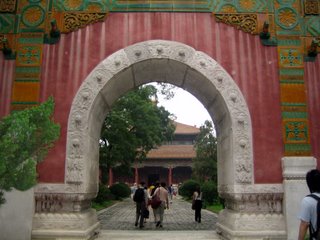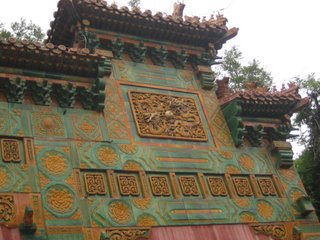The Imperial College

Guo zi jian, or the "Imperial College," was ancient China's highest seat of learning, combining the functions of what would now be called the Ministry of Education with those of a National University. It was once a stage for the Emperor, who frequently came here to read Confucian classics to an audience of thousands, mostly composed of civil and military officials from the imperial court and students of the Imperial College itself.

Students came here to study the Confucian classics in preparation for the imperial examinations. The college not only trained and educated the elite, but also received foreign students from numerous different countries promoting cross-cultural exchange. Those who tested best on the imperial examination were permitted to enroll in the College, and a special ceremony for the top scorers ensued. The main gate has not one, but three entrances: one for the second-place scorer, one for the third-place scorer, and the middle one, the largest, through which only the top scorer and the Emperor himself were allowed to pass. I'm not going to lie, it was kind of a thrill to walk through that archway...

Anyway, some brief info on the life and times of this very picturesque cultural site: the Imperial College was first established in 1287 during the Yuan Dynasty and subsequently enlarged several times, attaining its present dimensions during the reign of Emperor Qianlong of the Qing Dynasty. After the founding of the People's Republic in 1949, the Imperial College was completely renovated and the Capital Library was incorporated within its grounds.


Students came here to study the Confucian classics in preparation for the imperial examinations. The college not only trained and educated the elite, but also received foreign students from numerous different countries promoting cross-cultural exchange. Those who tested best on the imperial examination were permitted to enroll in the College, and a special ceremony for the top scorers ensued. The main gate has not one, but three entrances: one for the second-place scorer, one for the third-place scorer, and the middle one, the largest, through which only the top scorer and the Emperor himself were allowed to pass. I'm not going to lie, it was kind of a thrill to walk through that archway...

Anyway, some brief info on the life and times of this very picturesque cultural site: the Imperial College was first established in 1287 during the Yuan Dynasty and subsequently enlarged several times, attaining its present dimensions during the reign of Emperor Qianlong of the Qing Dynasty. After the founding of the People's Republic in 1949, the Imperial College was completely renovated and the Capital Library was incorporated within its grounds.

Apparently, the east and west halls of the Bi yong Hall (picture above: the east hall, unless my memory fails me) originally housed the famous "Qianlong Stone Scriptures." In the middle of the 18th century, Emperor Qianlong ordered to have the Thirteen Classics engraved in stone. To carry out this order, Jiang Heng, a scholar from Jiangsu Province, spent 20 years carving the 630,000 Chinese characters onto 189 stone tablets. Today these tables are located to the east of the Taixue Gate, so we didn't get to see them, but we did get to see where they used to be kept, as well as many photographs of the engraved tablets.

Look! A picture with people in it! From left to right:
[Back row]: Ben Jiemin (Yalie, super friendly; real name: Ben); Feng Shi (also from Yale, also super friendly -- fifth year, and my "big sister" for my Zhong guo jia ting experience... she's awesome); Ai Jingquan (another Yalie, from Canada, pretty cool guy as well, Kevin and I hung out with him for most of the trip; real name: Cameron); me and Kev, obviously... He Kaili and Zhuo Kaiwei for the purposes of this trip; two third-year graduate students whose names I do not know; a fourth-year named Bridget who doesn't talk much but stands around looking haughty and sort of bored... although she did talk to us a little.
[Front row]: fourth-year Yalie, friends with Feng Shi and dating Hao Ping; Hao Ping himself (real name unknown); Xiao Kan (my buddy, also a Yalie, real name: Colin); Liao Laoshi (small, awesome teacher, who Cameron told me we ought to nominate for "world's cutest teacher" ... it's true, she's like this continually-smiling little bouncy ball who also happens to teach you Chinese); Xiao Fei (from Harvard I believe, real name uknown, pretty quiet but quite nice); and, last but not least, Feng Dao (yet another Yalie, also my pal, Japanese with a Korean girlfriend [I think... don't quote me on that] and a big interest in modern architecture).
Phew.
[Back row]: Ben Jiemin (Yalie, super friendly; real name: Ben); Feng Shi (also from Yale, also super friendly -- fifth year, and my "big sister" for my Zhong guo jia ting experience... she's awesome); Ai Jingquan (another Yalie, from Canada, pretty cool guy as well, Kevin and I hung out with him for most of the trip; real name: Cameron); me and Kev, obviously... He Kaili and Zhuo Kaiwei for the purposes of this trip; two third-year graduate students whose names I do not know; a fourth-year named Bridget who doesn't talk much but stands around looking haughty and sort of bored... although she did talk to us a little.
[Front row]: fourth-year Yalie, friends with Feng Shi and dating Hao Ping; Hao Ping himself (real name unknown); Xiao Kan (my buddy, also a Yalie, real name: Colin); Liao Laoshi (small, awesome teacher, who Cameron told me we ought to nominate for "world's cutest teacher" ... it's true, she's like this continually-smiling little bouncy ball who also happens to teach you Chinese); Xiao Fei (from Harvard I believe, real name uknown, pretty quiet but quite nice); and, last but not least, Feng Dao (yet another Yalie, also my pal, Japanese with a Korean girlfriend [I think... don't quote me on that] and a big interest in modern architecture).
Phew.

This is the view from the main classroom building (in which no photos were allowed), called the Bi yong (Jade Disc) Hall. This square pavilion, standing in the center of a circular pond, has really lovely architecture, although I couldn't photograph it, featuring a double-eaved roof surmounted by a golden sphere on top. Outside, the pond is crossed by four marble bridges and provided on four sides with stone spouts in the shape of dragonheads. These bridges are strung from end to end with garlands of little red tasselled placards, which eager tourists and young college students from all over Beijing come to fill out with their wishes, hoping that placing their carefully penned hopes and schemes in this most auspicious of Chinese learning centers will make their dreams for the future come true.


<< Home